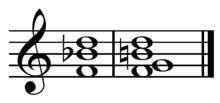♭VII–V7 cadence

In music, the ♭VII–V7 cadence is a cadence using the chord progression from the subtonic (♭VII) to dominant seventh (V7). It resolves to I making the full cadence ♭VII–V7–I.
A "mainstay in all rock styles of the '60s", the cadence occurs in Otis Redding's "(Sittin' On) The Dock of the Bay", Link Wray and His Ray Men's "Rumble", Duane Eddy's "Because They're Young", the Velvet Underground & Nico's "Sunday Morning" and "Femme Fatale", Joan Baez's "Fare Thee Well", and Al Caiola's 1961 "The Magnificent Seven" (0:15-0:17) and "Bonanza" (0:26-0:27).[1]
♭III–V7 cadence

A similar cadence to the ♭VII–V7 cadence is the ♭III–V7 cadence. In this cadence the ♭VII is replaced with the ♭III. In the key of C this would be E♭–G7–C (♭III–V7–I). Both the ♭VII and ♭III are altered chords or chords borrowed from the parallel minor.
This cadence occurs in The Beatles' "Something", Leroy Anderson's "Sleigh Ride", and Muse's "New Born".